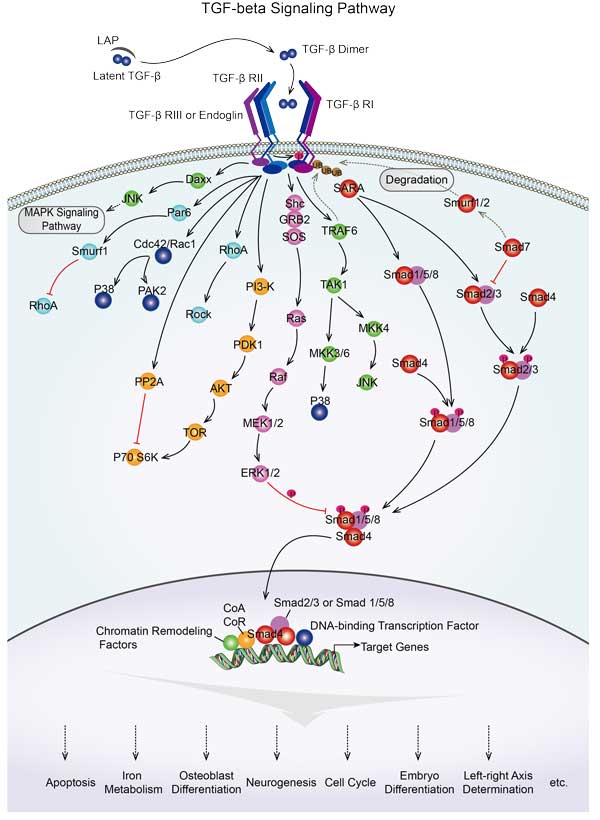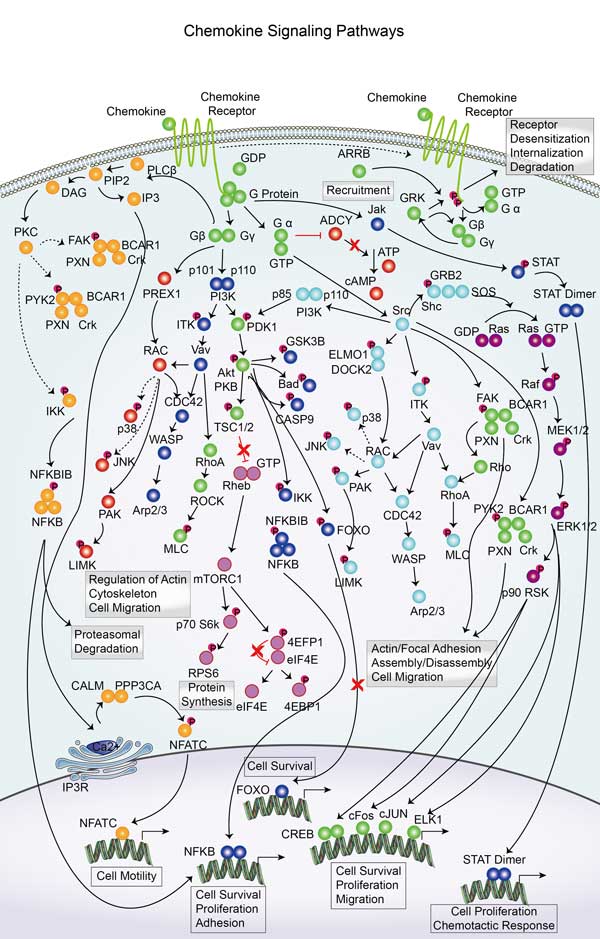CDC42
-
Official Full Name
cell division cycle 42 -
Overview
The protein encoded by this gene is a small GTPase of the Rho-subfamily, which regulates signaling pathways that control diverse cellular functions including cell morphology, migration, endocytosis and cell cycle progression. This protein is highly similar to Saccharomyces cerevisiae Cdc 42, and is able to complement the yeast cdc42-1 mutant. The product of oncogene Dbl was reported to specifically catalyze the dissociation of GDP from this protein. This protein could regulate actin polymerization through its direct binding to Neural Wiskott-Aldrich syndrome protein (N-WASP), which subsequently activates Arp2/3 complex. Alternative splicing of this gene results in multiple transcript variants. Pseudogenes of this gene have been identified on chromosomes 3, 4, 5, 7, 8 and 20. [provided by RefSeq, Apr 2013] -
Synonyms
CDC42;cell division cycle 42;G25K;CDC42Hs;cell division control protein 42 homolog;G25K GTP-binding protein;GTP-binding protein, 25kD;growth-regulating protein;GTP binding protein, 25kDa;small GTP binding protein CDC42;dJ224A6.1.1 (cell division cycle 42 (GTP-binding protein, 25kD));dJ224A6.1.2 (cell division cycle 42 (GTP-binding protein, 25kD))
Recombinant Proteins
- Human
- Zebrafish
- Rat
- Mouse
- Cynomolgus
- Chicken
- Rhesus macaque
- E.coli
- Wheat Germ
- Mammalian Cells
- HEK293
- In Vitro Cell Free System
- GST
- His
- pstS1
- Non
- T7
- DDK
- Myc
- Avi
- Fc
Background
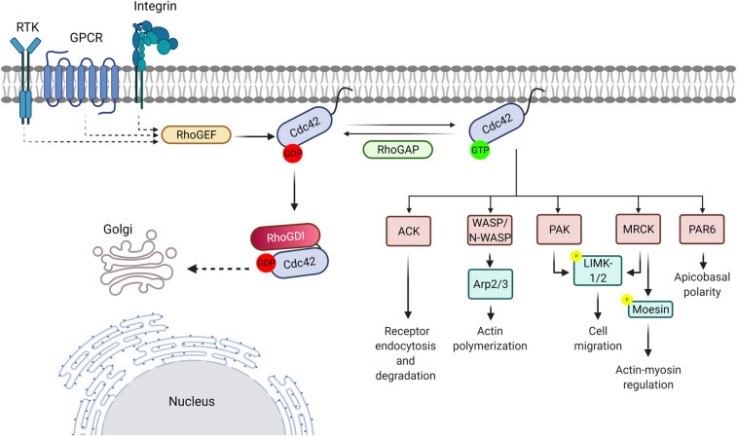
Fig1. The regulation of Cdc42. (Natasha P Murphy, 2021)
What is CDC42 protein?
CDC42 (cell division cycle 42) gene is a protein coding gene which situated on the short arm of chromosome 1 at locus 1p36. The protein encoded by this gene is a small GTPase of the Rho-subfamily, which regulates signaling pathways that control diverse cellular functions including cell morphology, migration, endocytosis and cell cycle progression. This protein is highly similar to Saccharomyces cerevisiae Cdc 42, and is able to complement the yeast cdc42-1 mutant. This protein could regulate actin polymerization through its direct binding to Neural Wiskott-Aldrich syndrome protein (N-WASP), which subsequently activates Arp2/3 complex. The CDC42 protein is consisted of 191 amino acids and its molecular mass is approximately 21.3 kDa.
What is the function of CDC42 protein?
CDC42 protein is an important regulator of cytoskeleton. It plays a "starting" role in the process of cell migration, which can promote the formation and extension of lamellar pseudopods under the cell membrane, and then push the cell forward. It is also involved in cell division, regulating the formation and localization of the spindle.
CDC42 Related Signaling Pathway
The CDC42 protein is a small GTP enzyme that belongs to the Rho family and plays a key role in a variety of signaling pathways. It is mainly involved in cytoskeleton organization, cell migration, cell division and intracellular signal transduction. In particular, during the process of cell division, CDC42 protein interacts with other proteins to regulate spindle formation and chromosome separation to ensure normal cell division. In addition, CDC42 is also involved in the regulation of cell polarity, cell adhesion and apoptosis.
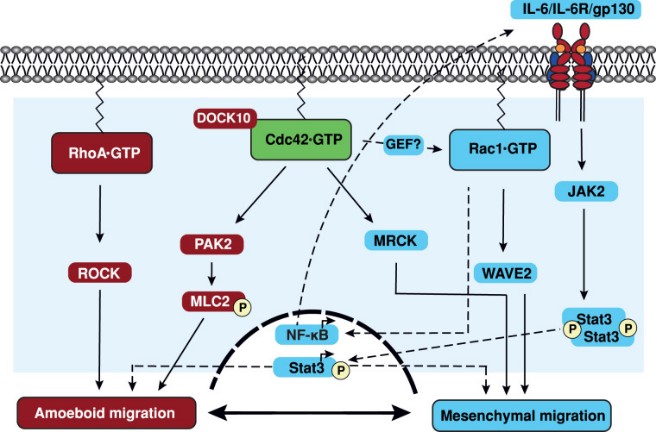
Fig2. Cdc42 signalling in cell migration. (Natasha P Murphy, 2021)
CDC42 Related Diseases
Abnormal activation of CDC42 has been linked to the progression of multiple cancers, including breast, colon, and lung cancers. Abnormal activation of CDC42 in nerve cells has been linked to the development of certain neurodegenerative diseases, such as Parkinson's disease and Huntington's disease. The abnormal regulation of CDC42 in immune cells may be related to the occurrence of some autoimmune diseases, such as rheumatoid arthritis. Mutations in its genes can lead to certain genetic disorders, such as congenital neutropenia. Other diseases include cardiovascular disease and inflammatory diseases.
Bioapplications of CDC42
CDC42 is associated with many diseases, and it is regarded as a new target for disease treatment, which helps to discover new therapeutic strategies. Because of its key role in a variety of diseases, CDC42 has become a popular target for drug development. At present, several small molecule inhibitors targeting CDC42 have entered the clinical trial stage.
Case Study
Case Study 1: Hui Cao, 2023
Cell division control protein 42 (CDC42) modulates insulin secretion and angiogenesis to participate in the pathology of diabetic complications and retinal vascular-associated diseases. This study intended to explore the role of CDC42 in the progression of diabetic retinopathy, and the underlying mechanism. Human retinal microvascular endothelial cells (hRMECs) were cultured in 5.5 mM glucose (normal glucose) or 25 mM glucose (high glucose; HG) medium, respectively. CDC42 overexpression plasmid and small interference RNA (oe-CDC42 and si-CDC42) or corresponding negative controls (oe-NC and si-NC) were transfected into hRMECs under HG. Then, platelet-activating factor C-16 (C16-PAF) (MEK/ERK pathway activator) was added to si-CDC42 or si-NC transfected hRMECs under HG. HG increased CDC42 mRNA and protein, cell viability, invasive cell count, branch points, and tube length but reduced cell apoptosis in hRMECs. CDC42 upregulation enhanced cell viability, invasive cell count, branch points, tube length, p-MEK, and p-ERK, but attenuated cell apoptosis. Downregulation of CDC42 exhibited opposite trends. In addition, C16-PAF also increased cell viability, invasive cell count, branch points, and tube length, p-MEK, and p-ERK, but retarded cell apoptosis.
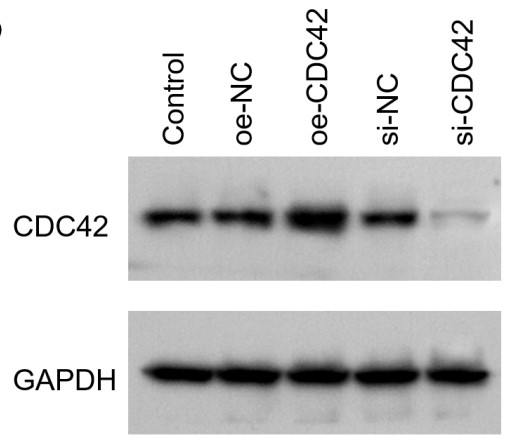
Fig1. Representative images of CDC42 protein by immunoblotting.
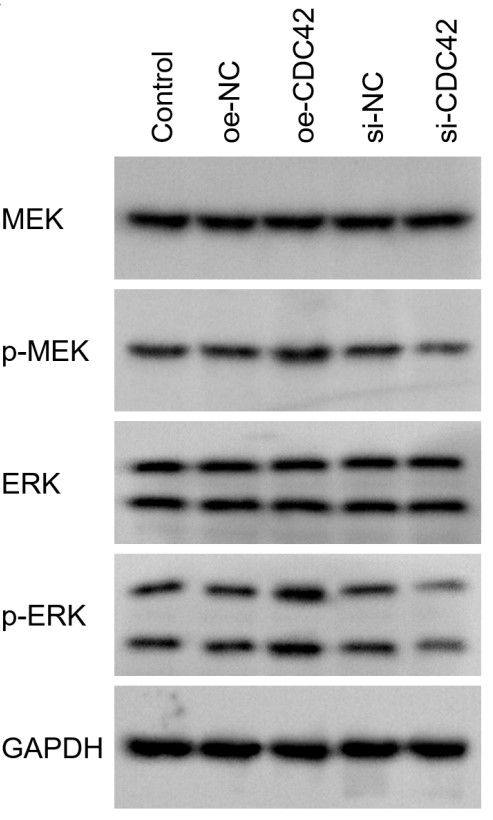
Case Study 2: Li-Li Ma, 2020
Microscopic indications of malignancy and hallmark molecules of cancer are pivotal to determining cancer patient prognosis and subsequent medical intervention. Here, the researchers found that compared to apical expression of Cdc42, which indicated that basal expression of Cdc42 occurred at the migrating cell front, glandular basal expression of Cdc42 (cell division cycle 42) in tissues indicated poorer prognoses for colorectal cancer (CRC) patients. The current study shows that activated Cdc42 was rapidly recruited to the migrating CRC cell front after VEGF stimulation through engagement of membrane-anchored neuropilin-1 (NRP1). When VEGF signalling was blocked with NRP1 knockdown or ATWLPPR (A7R, antagonist of VEGF/NRP1 interaction), Cdc42 activation and relocation to the cell front was attenuated, and filopodia and invadopodia formation was inhibited. The VEGF/NRP1 axis regulates directional migration, invasion, and metastasis through Cdc42 activation and relocation resulting from actin filament polymerisation of the extensions of membrane protrusions.
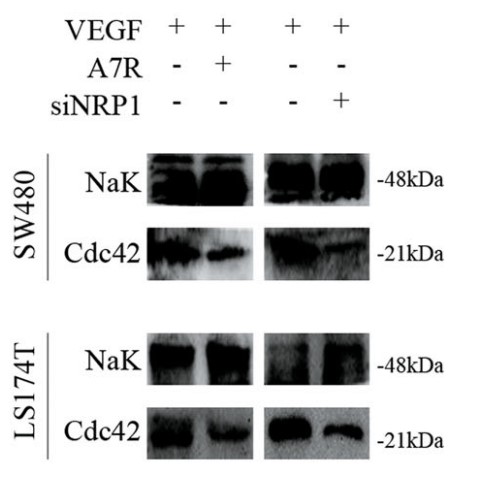
Fig3. Cell membrane fractions were isolated and probed for Cdc42.

Quality Guarantee
High Purity
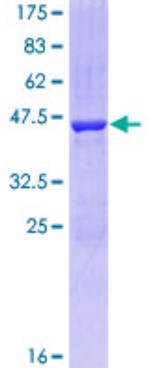
Fig1. SDS-PAGE (CDC42-0934H) (PROTOCOL for western blot)
.
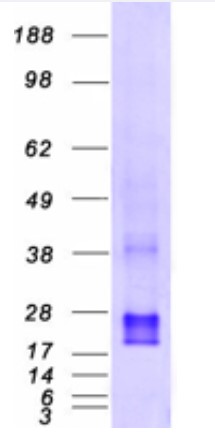
Fig2. SDS-PAGE (CDC42-1712H) (PROTOCOL for western blot)
Involved Pathway
CDC42 involved in several pathways and played different roles in them. We selected most pathways CDC42 participated on our site, such as MAPK signaling pathway,Ras signaling pathway,Rap signaling pathway, which may be useful for your reference. Also, other proteins which involved in the same pathway with CDC42 were listed below. Creative BioMart supplied nearly all the proteins listed, you can search them on our site.
| Pathway Name | Pathway Related Protein |
|---|---|
| Focal adhesion | RAF1,LAMC2,COL2A1B,CDC42L,ROCK2,TNW,THBS2,FYNA,TNK1,LAMA2 |
| Leukocyte transendothelial migration | F11R,NOX1,PECAM1,MMP9,MYLPF,PTPN11,CLDN7,MYL12A,OCLN,NIPAL1 |
| Viral carcinogenesis | SP100,RANBP1,HLA-C,HIST1H4N,TRAF2,GTF2H4,CDC20,YWHAG,PIK3CA,KRAS |
| Shigellosis | FBXW11,CD44,IKBKG,ARPC5L,ABL1,IL-8,NFKB1,IKBKB,SRC,MAPK11 |
| Regulation of Actin Cytoskeleton | FGF10A,TMSB4X,PIK3R5,ACTN4,ACTB,PAK6,ITGB2L,MYLK3,PPP1CAA,INS |
| Epithelial cell signaling in Helicobacter pylori infection | RELA,MAPK10,ATP6V1A,CXCR2,MAPK8,IL-8,ATP6V0E1,ATP6V1E1,CCL5,ATP6V1C1 |
| Bacterial invasion of epithelial cells | BCAR1,SEPT6,DNM3,PIK3R1,ACTG1,PIK3R2,MET,CAV1,ARPC1B,SEPT9 |
| Neurotrophin signaling pathway | RAPGEF1,GSK3B,MAP2K7,CAMK2G,AKT1,PIK3R2,CALML5,ARHGDIA,MAPK12,PTPN11 |
| Chemokine signaling pathway | CCL16,CCL22,CCL3L3,GNG4,CCR5,CCL20,SHC1,PRKCB,GRK5,PTK2B |
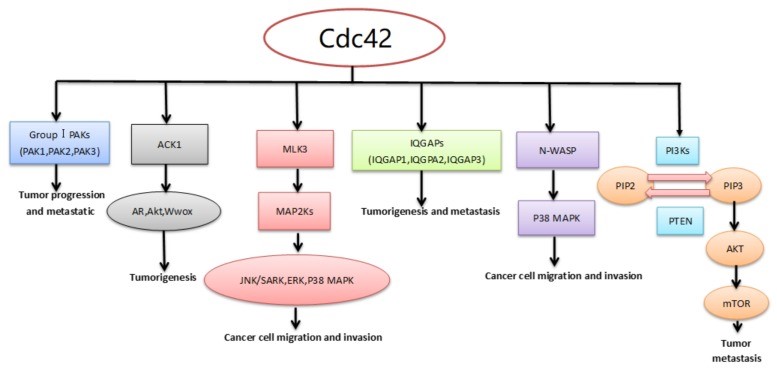
Fig1. Downstream effector/adaptor proteins of Cdc42. (Xing-Hua Xiao, 2018)
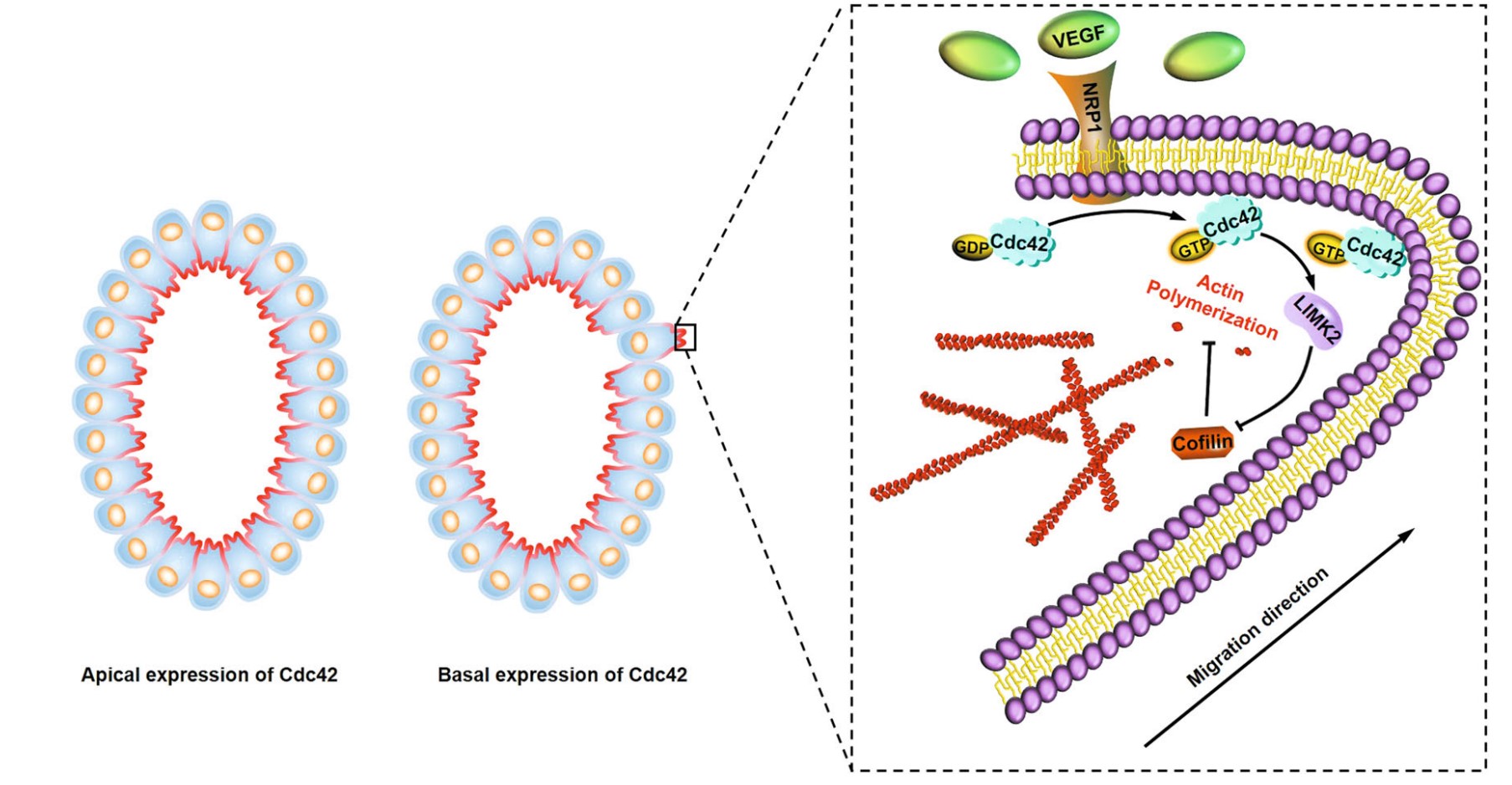
Fig2. Schematic of Cdc42 expression predicting the prognosis of colorectal cancer. (Li-Li Ma, 2020)
Protein Function
CDC42 has several biochemical functions, for example, GTP binding,GTP-dependent protein binding,GTPase activity. Some of the functions are cooperated with other proteins, some of the functions could acted by CDC42 itself. We selected most functions CDC42 had, and list some proteins which have the same functions with CDC42. You can find most of the proteins on our site.
| Function | Related Protein |
|---|---|
| mitogen-activated protein kinase kinase kinase binding | MAPK8IP3,MARVELD3,PPEF2,MAPK1,CDC37,MAP2K1,TRAF2,DUSP19,MAPK9,MAP4K2 |
| thioesterase binding | TRAF1,TRAF3,CALM1,CALM3,TRAF2,ADRA2A,TRAF6,ARF6,TRAF4,CALM2 |
| protein kinase binding | CCNL1A,PRKACA,CCNE2,CCND1,SOCS1,MAP3K5,TELO2,DNM2,MAPK6,NCS1 |
| apolipoprotein A-I receptor binding | APOA1,NR1H2 |
| GTP-dependent protein binding | PARD6A,RASGRP4,EEA1,AP1G1,RAPGEF6,ARFIP2,MRAS,AP3B1,RAB38,PPIAL4A |
| protein binding | MBNL3,LRRC29,MYOZ1,TFDP2,H1F0,NIF3L1,RFX6,EIF3B,ZC3HAV1,PCDH18B |
| GTPase activity | RAB25,MTIF2,TUBG1,RAB42B,RAB25B,EEF1A1B,RAB22A,TUBE1,GNAI2A,TUBA1B |
| ubiquitin protein ligase activity | RNF144A,RNF165,ZNRF1,UBE2G1,AMFR,HERC2,HECW2,MED23,RNF7,FBXL22 |
| GTP binding | EEF1A1L2,DRG2,TUBAL3,RAB6B,ATL1,RAB5AB,GNA11B,RAB37,TUBB4A,RAB1B |
Interacting Protein
CDC42 has direct interactions with proteins and molecules. Those interactions were detected by several methods such as yeast two hybrid, co-IP, pull-down and so on. We selected proteins and molecules interacted with CDC42 here. Most of them are supplied by our site. Hope this information will be useful for your research of CDC42.
PAK1;WAS
CDC42 Related Signal Pathway
Resources
Gene Families
Related Services
Related Products
References
- Matsuda, T; Yanase, S; et al. The immunosenescence-related gene Zizimin2 is associated with early bone marrow B cell development and marginal zone B cell formation. IMMUNITY & AGEING 12:-(2015).
- Tang, QH; Liu, ZY; et al. Involvement of activation of C-met signaling pathway in CD151-induced HUVECs angiogenesis. JOURNAL OF HUAZHONG UNIVERSITY OF SCIENCE AND TECHNOLOGY-MEDICAL SCIENCES 35:35-41(2015).


